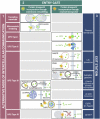Editorial: Unconventional protein secretion: From basic mechanisms to dysregulation in disease
- PMID: 36531948
- PMCID: PMC9748678
- DOI: 10.3389/fcell.2022.1088002
Editorial: Unconventional protein secretion: From basic mechanisms to dysregulation in disease
Keywords: cell adaptation; cell compartmentalization; disease; membrane trafficking; unconventional protein secretion (UPS).
Conflict of interest statement
The authors declare that the research was conducted in the absence of any commercial or financial relationships that could be construed as a potential conflict of interest.
Figures

Comment on
- Editorial on the Research Topic Unconventional protein secretion: From basic mechanisms to dysregulation in disease
References
Publication types
LinkOut - more resources
Full Text Sources

